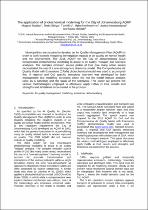JavaScript is disabled for your browser. Some features of this site may not work without it.
- ResearchSpace
- →
- Research Publications/Outputs
- →
- Conference Publications
- →
- View Item
| dc.contributor.author |
Naidoo, Mogesh

|
|
| dc.contributor.author |
Sibiya, Bhekizizwe A

|
|
| dc.contributor.author |
Bird, T

|
|
| dc.contributor.author |
Nekhwalivhe, M

|
|
| dc.contributor.author |
Netshandama, J

|
|
| dc.contributor.author |
Mahlatji, M

|
|
| dc.date.accessioned | 2017-10-16T11:40:19Z | |
| dc.date.available | 2017-10-16T11:40:19Z | |
| dc.date.issued | 2017-10 | |
| dc.identifier.citation | Naidoo, M., Sibiya, B.A., Bird, T. et al. 2017. The application of photochemical modelling for the City of Johannesburg AQMP. Proceedings of the 2017 Conference of the National Association for Clean Air, 4-6 October 2017, Cedar Woods of Sandton, Woodmead, Gauteng | en_US |
| dc.identifier.uri | http://www.naca.org.za/uploads/NACAProgramme2017V529.09.17.pdf | |
| dc.identifier.uri | http://hdl.handle.net/10204/9660 | |
| dc.description | Paper presented at the 2017 Conference of the National Association for Clean Air, 4-6 October 2017, Cedar Woods of Sandton, Woodmead, Gauteng | en_US |
| dc.description.abstract | Municipalities are required to develop an Air Quality Management Plan (AQMP) in order to work towards mitigating the negative impacts of air quality on human health and the environment. The 2016 AQMP for the City of Johannesburg (CoJ) incorporated photochemical modelling to assist in air quality “hotspot” and scenario analyses. The complex emission source profile of CoJ (like many urban areas) necessitated the use of a one-atmosphere chemistry model. The Comprehensive Air Quality Model with Extensions (CAMx) photochemical model was used to accomplish this. A regional and CoJ specific emissions inventory was developed for both management and modelling purposes; which fed into the model hotspot analysis (also as a baseline) and the basis of the scenarios. This paper will present the various methodologies employed to effectively apply CAMx in CoJ, results and strengths and limitations encountered in the process. | en_US |
| dc.language.iso | en | en_US |
| dc.publisher | National Association for Clean Air, South Africa (NACA) | en_US |
| dc.relation.ispartofseries | Worklist;19642 | |
| dc.subject | Air quality management | en_US |
| dc.subject | Comprehensive Air Quality Model with Extensions | en_US |
| dc.subject | CAMx | en_US |
| dc.subject | City of Johannesburg air quality | en_US |
| dc.title | The application of photochemical modelling for the City of Johannesburg AQMP | en_US |
| dc.type | Conference Presentation | en_US |
| dc.identifier.apacitation | Naidoo, M., Sibiya, B. A., Bird, T., Nekhwalivhe, M., Netshandama, J., & Mahlatji, M. (2017). The application of photochemical modelling for the City of Johannesburg AQMP. National Association for Clean Air, South Africa (NACA). http://hdl.handle.net/10204/9660 | en_ZA |
| dc.identifier.chicagocitation | Naidoo, Mogesh, Bhekizizwe A Sibiya, T Bird, M Nekhwalivhe, J Netshandama, and M Mahlatji. "The application of photochemical modelling for the City of Johannesburg AQMP." (2017): http://hdl.handle.net/10204/9660 | en_ZA |
| dc.identifier.vancouvercitation | Naidoo M, Sibiya BA, Bird T, Nekhwalivhe M, Netshandama J, Mahlatji M, The application of photochemical modelling for the City of Johannesburg AQMP; National Association for Clean Air, South Africa (NACA); 2017. http://hdl.handle.net/10204/9660 . | en_ZA |
| dc.identifier.ris | TY - Conference Presentation AU - Naidoo, Mogesh AU - Sibiya, Bhekizizwe A AU - Bird, T AU - Nekhwalivhe, M AU - Netshandama, J AU - Mahlatji, M AB - Municipalities are required to develop an Air Quality Management Plan (AQMP) in order to work towards mitigating the negative impacts of air quality on human health and the environment. The 2016 AQMP for the City of Johannesburg (CoJ) incorporated photochemical modelling to assist in air quality “hotspot” and scenario analyses. The complex emission source profile of CoJ (like many urban areas) necessitated the use of a one-atmosphere chemistry model. The Comprehensive Air Quality Model with Extensions (CAMx) photochemical model was used to accomplish this. A regional and CoJ specific emissions inventory was developed for both management and modelling purposes; which fed into the model hotspot analysis (also as a baseline) and the basis of the scenarios. This paper will present the various methodologies employed to effectively apply CAMx in CoJ, results and strengths and limitations encountered in the process. DA - 2017-10 DB - ResearchSpace DP - CSIR KW - Air quality management KW - Comprehensive Air Quality Model with Extensions KW - CAMx KW - City of Johannesburg air quality LK - https://researchspace.csir.co.za PY - 2017 T1 - The application of photochemical modelling for the City of Johannesburg AQMP TI - The application of photochemical modelling for the City of Johannesburg AQMP UR - http://hdl.handle.net/10204/9660 ER - | en_ZA |






